Appendix Ι
|
|||
Quickly read the text below about Karen hill tribes and find out the following (all of the answers are colours or numbers): a. What colour are the dresses which unmarried girls wear? b. How old are elephants when they start their training? c. What colour are the dresses which married women wear? d. What colour are the trousers which the men wear? e. How many years do elephants usually work? Compare your answers with your partner. |
|||
Task 1
Now read the text again more carefully and answer the questions which follow. The Karen hill tribes live in the mountains of Thailand. They live in bamboo houses and their farm animals, pigs, chickens and buffaloes, live under the houses. The Karen are very skilled at farming in difficult areas. The Karen are also good at training elephants. Elephant training begins when the animal is about four years old. The elephants learn how to pick things up, pull and push heavy things like trees which have been cut down. At about ten years old, the elephants start work and their working lives can last for about fifty years. They are unbelievably strong - a working elephant can lift 700kg! The Karen people have beautiful traditional costumes. Girls who are not married wear white dresses and married women wear blouses and skirts in bright red or blue. Karen men wear blue trousers and red or blue shirts. The Padaung is a group which belongs to the Karen hill tribes. Many Padaung women wear metal rings round their necks which make their necks look much longer than usual. Their mythology explains that this is done to stop tigers from biting them! However, the usual explanation is that a very long neck is beautiful. Today, many tourists visit the mountains in Thailand to see the Karen hill tribes and the beautiful women in their traditional costumes. |
|||
It’s your choice!
|
|||
It’s your choice!
|
||||||||||||||||||||||
Tick TRUE or FALSE to the following statements. Check your answers with your
partner.
|
||||||||||||||||||||||
Task 2
Complete the dialogue by underlining the correct word in italics. A: Hi Tina, how was your holiday in Thailand? B: Oh, hi Christos, it was great! We went everywhere, even to the animals/mountains. We saw some Karen hill tribe people - they're fascinating/ fascinated. They play/train elephants, you know A: I didn't know that. What do the elephants do? B: Well, elephants are really strong/work and they can lift/eat heavy things, so they help the Karen people when they are cooking/farming in the forests. A: Really? Weren't you frightened/frightening? B: Oh, no. Elephants are very gentle and friendly. We also saw some Padaung women wearing big rings/shirts round their necks which make their necks look really long/heavy. A: Oh, you're so lucky! I wish I could go there. B: Never mind! Let's look on the Internet, there's lots of information about elephants/tribes all over the world. A: Great idea! Check your answers and act out the dialogue with your partner. |
||||||||||||||||||||||
Task 3
Work with a partner to find out about another fascinating tribe of people and then tell the class about what you've found out. |
||||||||||||||||||||||
Appendix I
|
|
 Reading Reading Lead-in Quickly read the text and find out the following: a. How tall are these people? b. Which part of the world do they live in? c. How do the children spend their time? d. What does ‘Ba' mean? e. What is ‘Jengi'? Compare your answer with your partner. |
|
| The Children of the Forest In his new book ‘Peoples of the World', Brian Greene looks at the life of different tribes in Africa. For the final part of the book, he travels to Cameroon to learn about the Pygmies. Who are they? Some people call the Pygmies ‘The Children of the Forest' because they are very short. Usually they grow to between 120 and 130 centimetres tall. They are very kind and gentle and you see this in their music, dances and songs. Their songs describe life and their survival. They live in the forests of central and western Africa. There are many different Pygmy groups such as the Bambuti, Batara, Bayaka and Bagyeli. The beginning of each name ‘Ba' means people. Although they all speak different languages, one word which is the same in the different tribes is the name of the forest spirit - Jengi. |
|
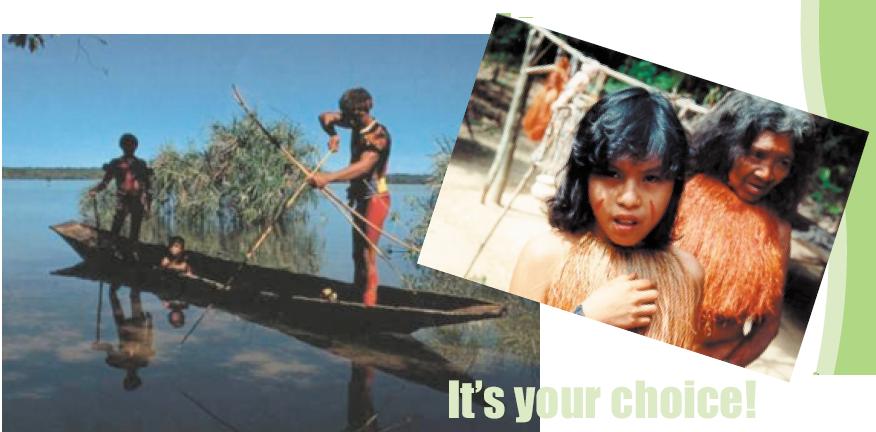 |
|
It’s your choice!
|
||||||||||||||||||||||||||
|
||||||||||||||||||||||||||
| How do they live? The Pygmies are nomads and move from place to place on foot. They take the important things with them and build a new village in another part of the forest. As nomads, they move to another part of the forest when the area where they are living becomes dirty. It becomes dirty because they do not clean anything and instead they move away from the rubbish. They live in huts, which they make from branches and leaves of trees. All Pygmies live in groups of families. They do not live in villages but their homes are near farming villages. This allows them to sell or exchange the forest plants and wood for crops which they eat, and other goods they use to live on. The male hunts animals such as pigs, and monkeys. He uses a spear and bow and arrows to hunt. The female looks after the children and she gathers honey, wild berries and other plants. The family eats the food at once because it does not have a way to keep it fresh. The children help their parents and do not go to school because the family does not stay in one place very long. What problems do they face? The Pygmies face three problems. First, big companies are cutting down the trees and the Pygmies do not have anywhere to live. The second problem is that the government in each country is taking the forests to make national parks for tourists. Also, many foreign people are coming into the areas where the Pygmies live and they are building houses on the Pygmy land. |
||||||||||||||||||||||||||
Use all the text, and tick TRUE or FALSE to the following statements. Check your
answers with your partner.
|
||||||||||||||||||||||||||
Task 2
Read the whole text again and complete the chart below with examples for each.
The Pygmies
|
||||||||||||||||||||||||||
Appendix I
|
||||||||||||||||||||||||||
|
||||||||||||||||||||||||||
Task 4 - Pairwork
Student A reads the text about children's lives in ancient Athens. Student B turns to p.126. In ancient Athens, not many girls went to school, most of them stayed at home. In rich families, teachers came to the house to teach them how to sing and play musical instruments. Athenian girls also learnt how to make the family's clothes. At the age of fifteen, a marriage was usually arranged for them. Most boys of rich families in Athens went to school where they learnt to read and write and do mathematics. Some boys also had the chance to discuss philosophy and learn public speaking. Sometimes, the boys also learnt to dance and play a musical instrument. Games and athletics were also important in all schools. Some boys who did not go to school stayed around the public baths and gymnasia and learnt from the men who spent long hours talking there. Rich young Athenian boys had slaves to take them to school and look after them. Your partner has information about life for children in ancient Sparta. Write the words in the correct order to make questions and ask your partner to find out about these things.
|
||||||||||||||||||||||||||
Task 5
With your partner, fill in the grid to show what boys and girls did in Sparta and Athens.
|
||||||||||||||||||||||||||
It’s your choice!
|
||||||||||||||||||||||||||
It’s your choice!
|
|||||||||||||||||||
Student B read the text about children's lives in ancient Sparta. Spartan girls did not go to school; they learnt skills such as singing, dancing and reading poetry at home. Some of them also learnt how to play a musical instrument. The Spartans believed that everyone should be fit and healthy and so girls also did some physical training and played many games. Nurses looked after the children and slaves did the work in their houses. So, Spartan women probably had quite a lot of free time. Life was very difficult for Spartan boys. At the age of seven boys had to leave their family to live in a kind of school. They had to collect plants from rivers to make their beds, their clothes were not warm enough and they did not wear shoes. Their food was horrible and, because they didn't have enough to eat, they had to steal food from farms. If someone found them when they were stealing, they were punished. At school, they had lessons in reading and counting, they did military exercises and they played many hard team games and they were punished if they did not do what they were told. Their education made them become very strong and tough soldiers. Your partner has information about children's lives in ancient Athens. Write the words in the correct order to make questions and ask your partner to find out about these things. |
|||||||||||||||||||
| a. what/ girls/ do/ home/ did/ at? b. They/ did/ learn/ to/ how/ play/ instrument/ a/ musical? c. Do/ what/ girls/ did/ years/ old/ at/ fifteen? d. Most/ go/ boys/ did/ school/ to? e. where/ boys/ spend/ did/ of/ a/ lot/ time? f. rich/ boys/ have/ slaves/ did? |
|||||||||||||||||||
Task 6
Work with your partner to make a week's timetable for a) a Spartan school or b) an Athenian school.
|
|||||||||||||||||||
Appendix Ι
|
|||
Unit 2 Making a difference
|
|||
| STUDENT A The Life of Laskarina Bouboulina Laskarina Bouboulina was born in a prison in Constantinople on (1) …………………… (When?). Soon afterwards, her mother returned to the island of Hydra, where they lived for almost (2) …………………… (How long?) and then they moved to Spetses. From childhood Bouboulina had a passion for the sea and for ships. Every day, she (3) …………………… (What?) and spent hours listening to the stories of the sailors and their talk of freedom for the country. She had (4) …………………… (How many?) half-brothers and sisters and was their unchallenged leader. She married twice, first at the age of seventeen to (5) …………………… (Who?), and again at the age of thirty to Dimitrios Bouboulis. Life though was very cruel to Bouboulina, and both her husbands, captains of their own ships, died (6) …………………… (How?) who were then raiding the coasts of Greece. By 1811 Bouboulina the mother of (7) …………………… (How many?) was twice widowed, but at the same time she was extremely rich from the fortunes of ships, land and cash she inherited from her husbands. The cash alone which she inherited from Bouboulis, was over (8) ……………………… (How much?) - Spanish golden sovereigns of those days. She managed not only to keep this fortune intact but also to increase it due to her good management and (9) …………………………… (How?). She became partner in several Spetsiot vessels and soon managed to build three of her own. While she was in Constantinople in 1818, Bouboulina became a member of the underground organization, Filiki Etairia (Friendly Society). Bouboulina was the only woman who was allowed to join this organization, as (10) ……………………………… (Why?) in their ranks. She spent her fortune on war ships for a number of years and gave large amounts of food and money to the Greek armies which fought at Nafplion and Tripolis. In this way, she managed to spend the whole of her fortune during the first two years of the war, which lasted for nearly seven years. |
|||
It’s your choice!
|
|||
It’s your choice!
|
|
 |
|
| STUDENT B The Life of Laskarina Bouboulina Laskarina Boubouline was born in a prison in (1) ……………………… (Where?) on May 12 1771. Soon afterwards, her mother returned to the island of Hydra, where they lived for almost four years and then they moved to (2) ……………………… (Where?). From childhood Bouboulina had a passion for the sea and for ships. Every day, she played by the seashore and spent hours listening to the stories of the sailors and their talk of (3) ……………………… (What?). She had eight half-brothers and sisters and was their unchallenged leader. She married (4) ……………………… (How many times?), first at the age of seventeen to Dimitrios Yiannouzas, and again at the age of (5) ……………………… (How old?) to Dimitrios Bouboulis. Life though was very cruel to Bouboulina, and both her husbands, captains of their own ships, died in sea battles with the pirates who were then raiding the coasts of Greece. By 1811 Bouboulina the mother of seven children was twice widowed, but at the same time she was extremely rich from the fortunes of ships, land and cash she inherited (6) ……………………… (How?). The cash alone which she inherited from Bouboulis, was over 300,000 tallara - Spanish golden sovereigns of those days. She managed not only to keep this fortune intact but also to increase it due to her good management and successful trading. She became partner in several Spetsiot vessels and soon managed to build three of her own. In (7) ……………………… (When?), she went to Constantinople and while she was there she became a member of the underground organization, (8) ……………………… (What?) (Friendly Society). Bouboulina was the only woman who was allowed to join this organization, as they would not accept women in their ranks. She spent her fortune on war ships for a number of years and gave large amounts of food and money to (9) ……………………… (Who?) which fought at Nafplion and Tripolis. In this way, she managed to spend the whole of her fortune during the first two years of the war, which lasted for nearly (10) ……………………… (How long?). |
|
Appendix Ι
|
|||
Unit 3 Technology in our lives
|
|||
Task 1
Complete the following e-mail by choosing the correct word from the words given in italics.  Hi Jim, How are you? I'm using my dad's new laptop computer to send you this e-mail! It's easier/easy than writing a letter and it's also most/more fun! Computers are amazing, aren't they? This laptop is much better/best than my dad's old computer. It's fastest/faster than the old one and the graphics are more/most colourful. My dad's really interested in new technology now and he says he might even buy me a play station. The problem is that I want the PS 3 which is the more/most expensive model and dad says he'll only buy the PS 2 which is cheapest/cheaper than the PS 3. But I want one like yours - it's the good/best! How about coming over to my house tomorrow? Don't forget to bring your PS 3 - if my dad likes it, he might buy me one too! See you |
|||
Task 2
You would like to buy a new mobile phone. Look at the information below and then write an e-mail to your friend telling her/him about why you'd like to buy the new model. Use the e-mail above to help you.
|
|||
It’s your choice!
|
|||
It’s your choice!
|
||||||||||||||||||||||||||
 Hi Maria, Guess what?! My parents say that I can buy a new mobile phone - at last! The one I've got is so old, I hate it. The one which I want to buy is a ……………………. model and it's the ……………………. beautiful mobile phone I've ever seen! It's red and it's …………………… and …………………… than this old thing that I've got now. But the ………………….. important thing for me is that the one I want to buy has got an MP 3 player, which is fantastic. Also, it's got a much ………………….. memory than my old one so I can have lots of songs on it. I can't wait to show it to you when I get it. Love, Martina |
||||||||||||||||||||||||||
Task 3
Work in pairs. Go around the class and ask your classmates about computer games. You can ask: a. Do you play computer games? b. How many hours a week do you play computer games? c. Why do you like computer games? d. What's your favourite game? Make a table like this and tick the boxes with the information you find out.
|
||||||||||||||||||||||||||
Task 4
Tell the class about what you found out in Task 3. Tell them: a) how many hours your classmates usually play computer games each week; b) why computer games are popular in your class; c) what the most popular game is. You can start like this: a. The children in the class usually play computer games for……………….. b. Computer games are popular because ……………………………. c. The most popular computer game is………………………. because……………………….. |
||||||||||||||||||||||||||
Appendix Ι
|
|
Task 5
Look at the cartoon below. What is the point the cartoonist is making? Discuss the ideas given and choose one you think fits best, or decide on your own title with your partner. a) TV is interesting. b) The best form of entertainment is TV. c) Our need of the TV. 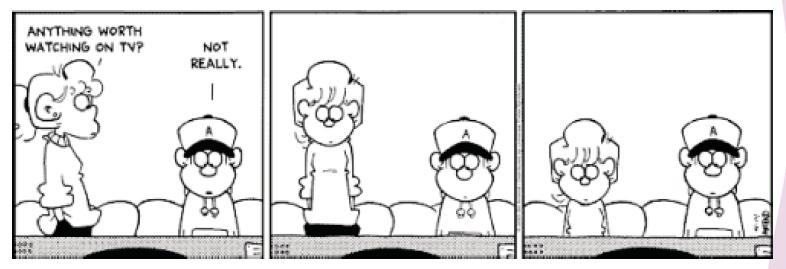 |
|
Task 6
Read the following statements in pairs. Do you agree or disagree with each statement? Discuss your ideas with your partner and say why you agree or disagree. |
|
| STATEMENTS 1. “We are ruled by TV”. 2. “They put an off button on the TV for a reason. Turn it off.” 3. “If you spend 20 hours per week watching television, by the age of 70 you will have spent 7 years of your life watching TV.” 4. “You watch television to turn your brain off and you work on your computer when you want to turn your brain on.” 5. “Television is leading people in each country becoming more dumb and unable to think critically”. 6. “Divorce, negative influences from the media, and materialism are the three greatest threats to families in society.” |
|
It’s your choice!
|
|
It’s your choice!
|
|
Task 7
The chart below is ‘The Kaufman Spectrum of Television Addiction’ and is intended to help those people who wish to escape from the grasp of television. The spectrum shows four phases and by moving up or down the scale we can change our viewing habits. Read the chart and find what kind of viewer you are. Compare your viewing habits with your partner. Which of you needs more help to stop watching so much TV? 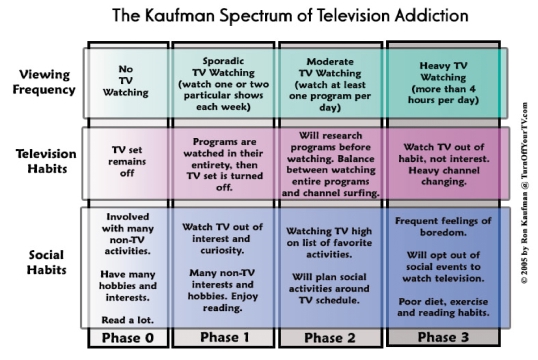 |
|
Task 8
Use the chart to interview four friends or family members to see how much help they need with their TV viewing habits. |
|
Appendix Ι
|
|||
Unit 4 Communication
Quiz
Work with a partner to answer the questions in the quiz. Look at p.134 to check your answers.
|
|||
It’s your choice!
|
|||
It’s your choice!
|
|||
| Quiz key: 1. a 2. c 3. a 4. b 5. b 6. c | |||
 Reading Reading Task 1
1. ………………………………. The Japanese are very polite and they nearly always bow to people when they meet them. They don't touch each other very often and, sometimes, they don't even look at the person they're talking to! 2. ……………………………….. If a Japanese person invites you to his house, you must be sure to take your shoes off before you go in. The Japanese don't wear shoes at home because shoes aren't clean enough. |
|||
|
|||
Appendix Ι
|
|||
Task 2
Read the description of a dream and fill the gaps with the words given. Last night I had a very strange (1) ………………. I dreamt that it was a beautiful day and I was walking in the countryside but I wasn't wearing any (2) ………………… Strangely, my feet didn't hurt me. I walked for a long time until I saw a little forest of olive (3) ………………….. and I went to pick some olives. The funny thing was, I could even pick the olives from the highest branches because my (4)……………….. were so long! Then, I put all of the olives into a big (5) ………………….. that I was carrying with me. I felt tired suddenly and decided to go home. When I got there, I saw lots of (6) ……………………. all flying around my house. It was amazing! |
|||
| arms bag trees bees dream shoes | |||
|
|||
Task 4
Find a song with the title ‘Sweet Dreams are made of this’ and report to the class what the song is about. |
|||
It’s your choice!
|
|||
It’s your choice!
|
|||||||||||||||
Unit 5 Change and Experience |
|||||||||||||||
Task 1
In pairs, go around the class and find out how many children have done these things in the last month. Fill in the table.
|
|||||||||||||||
Task 2
Use the information you found out in Task 1 to make a bar chart showing the number of children who have done each of the activities in the questions. 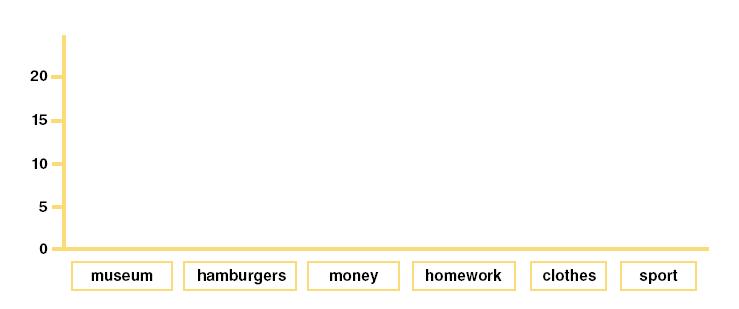 |
|||||||||||||||
Appendix I
|
|
Task 3
Fill in the spidergrams below with things that you can do or see in each place. You can look at pages 52 and 53 for ideas. 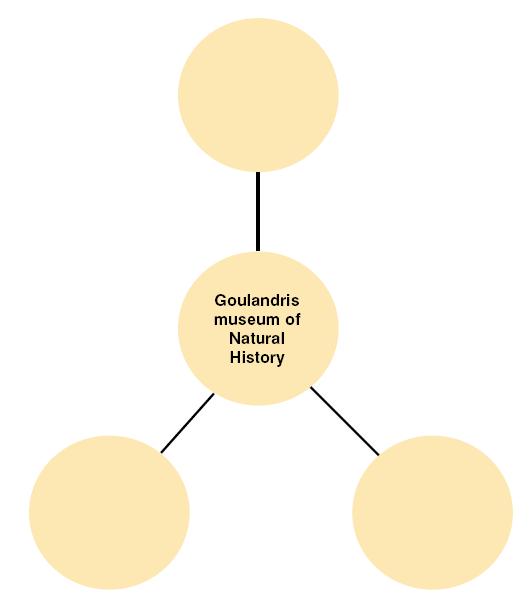 |
|
It’s your choice!
|
|
It’s your choice!
|
|
 |
|
Task 4
Think of a capital city (eg. London). Find information about what you can do there by looking it up on the Internet. When you find the information, imagine that you are on holiday in that city and write a short postcard to a friend telling him/her what you've been doing there since you arrived. Look at page 53 to get some help with writing postcards. |
|
| ......................................................................................................................................................... ......................................................................................................................................................... ......................................................................................................................................................... ......................................................................................................................................................... |
|
Appendix I
|
|||||||||||||||||||||||||||||||||
|
|||||||||||||||||||||||||||||||||
| Read the texts below and find a suitable visual for each. 1. The Olympic Games began at 776 B.C. in ancient Olympia. They were carried out every four years and they were part of celebrations in honour of Zeus. The winners took as awards olive branches that were the symbol of life. 2. The return of sculptures of Parthenon concerns all civilized world. Only the mutilated figures of Cecrops and one of his daughters, last remains of the ancestral glory and guards of their native land, are seen at the monument! Read the list of sites and mark where each one is on the map of Greece.
|
|||||||||||||||||||||||||||||||||
It’s your choice!
|
|||||||||||||||||||||||||||||||||
It’s your choice!
|
|||
Unit 6 What a waste! |
|||
Lead-in
In pairs, ask and answer these questions. What will you do if: a) it rains all day tomorrow? b) your teacher says the class will have a test tomorrow? c) you see someone throwing a lot of litter in the street? |
|||
Task 1
Look at the vocabulary in the box on p.62. Choose four of the items and write them in a list in your notebook. Write what you can make from each one. For example:
|
|||
|
|||
Appendix I
|
|
Task 3
Read what the children from around the world say about environmental problems in their area. 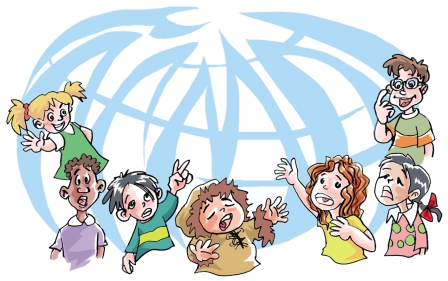
1) An Eskimo child from Greenland - “The ice is melting because of global warming so it's more difficult for us to hunt for food.” 2) A Chinese child - “I live in Beijing and there are so many factories near the city that we can't even see clearly because of the air pollution.” 3) A British child - “In Britain, too many people use plastic bags to carry their shopping” 4) A Mexican child - “In Mexico City, there are too many cars so the air is always polluted”. 5) An Indian child - “I live in Mumbai and they are building so many new buildings that there aren't any parks where we can play.” Work with a partner to think up solutions to the problems which the children talk about. Write the solutions using first conditional. You can get ideas on pages 63 and 64. For example: 1) If we all look after the environment, the ice will stop melting. |
|
Task 4
Work in a group in the class to make a poster showing the problems and solutions from Task 3. Put your poster up on the wall in your classroom. |
|
It’s your choice!
|
|
It’s your choice!
|
|
Unit 7 Magnetism and the world we live in |
|
 Reading Reading
A. Read the three texts below and find an example in each of the effects of magnetism. Compare your answer with your partner. |
|
| Text A Our planet has a magnetic field. On the earth's surface, it is weaker than the typical magnet you find on your fridge door. We see the affect of magnets in our everyday lives. It is common to see a television or computer screen shaking when a mobile phone rings next to it. |
|
| Text B Scientists used to believe that animals used their instinct to migrate but now they know that
they also use magnetic fields. Scientists believe that animals like turtles or birds have a
magnetic sense. Cells in an animal's brain contain magnetite that acts like a compass needle.
This helps birds to find their way when they fly north or south. |
|
| Text C In December 1947 five military planes took off from Ft Lauderdale, Florida at just after 2 pm. An
hour later the pilot sent a radio message. He said that the compasses were broken and they
didn't know where they were. The mystery is why ships and planes disappear in the area of the
Atlantic Ocean near Bermuda. Scientists believe that iron ore under the surface of the earth can
cause a false compass reading. |
|
B. Read the 3 texts again carefully and discuss with your partner which text mentions: a) the negative effects of magnetic fields, b) something electrical in a kitchen c) animals and magnetism. C. In pairs, decide which of the texts mentions something mysterious. |
|
Task 1
In pairs, discuss if you think there are magnets in: - a mobile phone - a car door - a fridge door - a music cassette - a printer - a speaker Check your answers by looking on the internet (you can find more information from a relevant internet site given on p. 190). |
|
Appendix I
|
|||||||
 Writing - Class Newspaper Writing - Class Newspaper
|
|||||||
| A. Look at the titles of the Greek and English newspapers. What problem does each
one refer to? B. As a group, write a newspaper article on how we can help the turtles survive. You can help protect sea turtles by telling people not to drive cars or motorbikes on the beach. Tell people to be careful where they walk during the nesting seasons! You can also help by picking up rubbish along the beach. Do not throw junk on the beach and always put your litter in trash cans. C. Create a class newspaper with different themes. As a class you are going to prepare a class newspaper. Decide who will be responsible for the different parts of preparing the newspaper.
|
|||||||
It’s your choice!
|
|||||||
It’s your choice!
|
|||||||||||||||||||
Unit 8 Getting around |
|||||||||||||||||||
Public Transport in Athens
An English speaking friend is going to spend a few days in Athens. Look at the different ways of getting around and write a short note to tell him/her how to use each means of transport. Choose a means of transport you think is friendly for people to use in a city and present it to the class. Give your reasons. 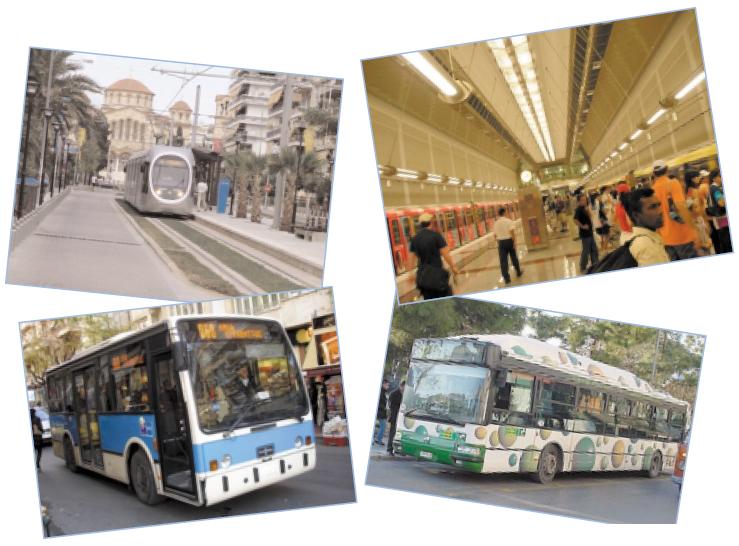 |
|||||||||||||||||||
|
|||||||||||||||||||
|
|||||||||||||||||||
Appendix I
|
|||
|
|||
Now do the same with the following spidergrams.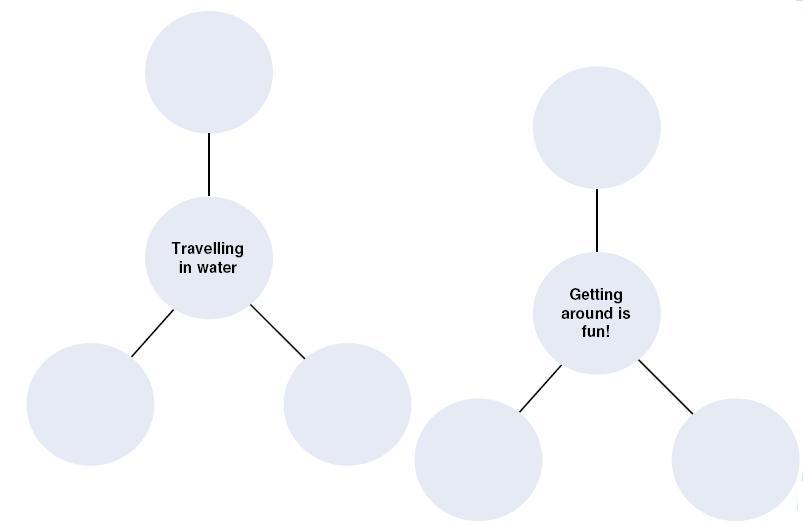 |
|||
It’s your choice!
|
|||
It’s your choice!
|
|

Task 2
Look at the question tags and the idioms of travel on page 91 and complete the dialogue with the correct word. |
|
Paul: Hi, George! How are you? George: Hi Paul! Don't ask! My neighbour's really 1)………………. me crazy. Paul: Why? What's the matter? You usually get on well together, 2)…………….. you? George: Not any more. I lent him some money and he won't pay me back. I think he's taking me for a 3)………………. It isn't fair, 4)………… it? I think I'll go round to his house and tell him what I think. Paul: Hold your 5) ……………………. for a minute, George. You don't want to 6)……………………. the boat, do you? I mean, he's your friend. Wait and see. He promised to give you the money, 7)………………….. he? George: Yes, he did but I gave him the money ages ago. I can't risk losing it, 8) ……………….. I? Paul: No, of course not. Well I hope you find a solution. George: So do I! |
|
Now act out the dialogue with a partner. |
|
Appendix I
|
|||||||||||||
Task 3
Read the two texts about two teenagers who live in different areas. Circle all the words which refer to transport. Text 1 |
|||||||||||||
| My name's Michelle and I've lived in a big city all my life. Getting around is very easy because the public transport is good, so I don't have to get lifts in my parents' car. We live near the local underground train station so you can travel into the city centre quickly and easily. There are also high speed trains which go all over the country. My favourite transport in the city is the tram which takes you around the centre. That's how I travel when I go shopping. | |||||||||||||
| Text 2 | |||||||||||||
| I'm Robin and I live in a small village in the heart of the countryside. The public transport is so bad that most people go everywhere by car and my mum has to give me a lift if I want to go outside the village. There's a local bus service but the bus only passes once a day so it's useless. I have to walk to school and when I visit my friends or go shopping in the village I have to cycle. | |||||||||||||
Task 4
Complete the table with the words you circled in Task 3. Ask your classmates which means of transport they use and tick the boxes.
Optional: Now make a pie chart showing the information in Task 4. 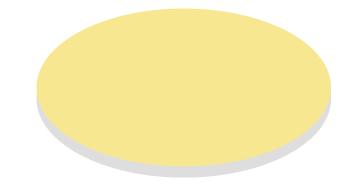
|
|||||||||||||
It’s your choice!
|
|||||||||||||
It’s your choice!
|
|||||||||||||||
Unit 9 Keeping up appearances |
|||||||||||||||
|
|||||||||||||||
Task 3
Go around the class to find out what your classmates are wearing. Tick the boxes to complete the table. You can add some other clothes to the list in the table.
Task 4
Make a pie chart to show how many students are wearing each item of clothing. |
|||||||||||||||
Appendix I
|
|||||
 Writing - ‘Teen worries’ Writing - ‘Teen worries’
Task 1
In pairs, look at the cartoon and write down three things that the teenagers worry about concerning their appearance. 
|
|||||
It’s your choice!
|
|||||
It’s your choice!
|
||||||||||||
Task 2
A. Read the short texts i-iv from a teen magazine where young people write about their worries and then read the advice from the magazine columnist. In pairs, rate these worries according to how important you think they are.
Then, chose one of the problems and think of ideas to help the writer. For example, if someone doesn't know how to match clothes, you might say: - If I were you, I would choose clothes that have the same colours - Think about the reason you need to go somewhere |
||||||||||||
Appendix I
|
|||
Mini-Quiz
a) Byzantine notes were: ni, pa, vu, ga, di, ke, zo. What is the music scale in the Western world? b) What was most unusual about the composer Beethoven?
Task 2
In groups of three, decide on a topic area and make four short simple statements about the topic. Then, decide on a rhythm or use the rhythm of any song you know. Sing your song. |
|||
It’s your choice!
|
|||
It’s your choice!
|
|||
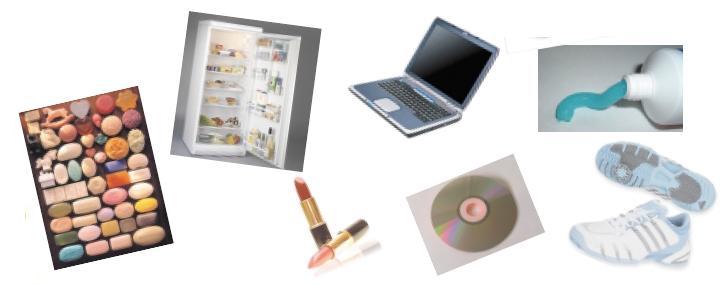
Task 1
Read the text on plastic and match the objects to a country on the world map. Write the name of the object in the space for each of the six countries. |
|||
|
|||
Appendix I
|
|
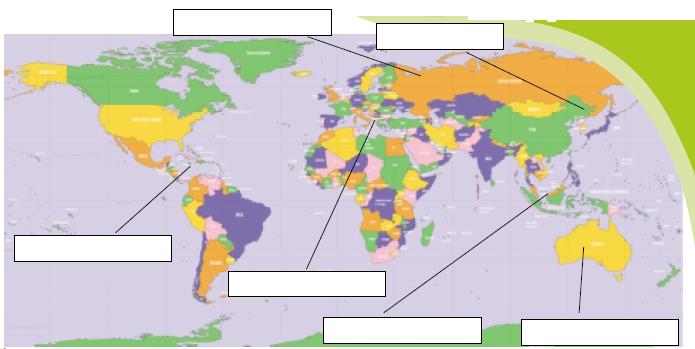  Writing Writing
Read the information in the letter below and in the Product Order Form about an order sent to Amazon internet service. A school boy ordered CDs but he hasn't received them yet.  Now look at the notes made by the Amazon staff on the Product Order Form and write an email from the company manager to explain what has happened. Begin your email like this: |
|
 Dear Christos, We are sorry about the delay in sending the CD's ordered. Unfortunately, .......................................................................................................................................................................................... .......................................................................................................................................................................................... |
|
It’s your choice!
|
|